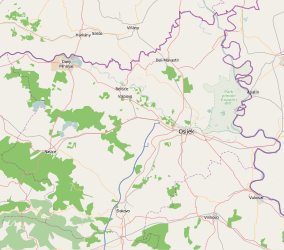Darda, Croatia
| Darda | ||
|---|---|---|
| Municipality | ||
| Municipality of Darda Općina Darda | ||
 | ||
| ||
 Darda  Darda Location of Darda in Croatia | ||
| Coordinates: HR 45°37′34″N 18°41′33″E / 45.626082°N 18.692513°E | ||
| Country |
| |
| County |
| |
| Government | ||
| • Mayor | Anto Vukoje | |
| Area | ||
| • Total | 94.24 km2 (36.39 sq mi) | |
| • Village | 73.18 km2 (28.25 sq mi) | |
| Population | ||
| • Total | 7,062 | |
| • Village | 5,394 | |
| Time zone | CET (UTC+1) | |
Darda is a village and a municipality just north of Osijek, Croatia. It is located across the Drava river in Baranja. The population of the village is 5,394, with a total of 7,062 people in the municipality.
Name
In Hungarian the town is known as Dárda, in German as Lanzenau, and in Serbian Cyrillic as Дарда.[1] In Hungarian, Dárda means a dagger rammed in a long handle, a military weapon used by the cavaliers and the infantry in the old times[2] (near equal as spear, pike or lance), while other's suggest that it probably comes from Illyrian language, today's Albanian, which can be translated directly from Albanian dardhë = pear.
History
It was first mentioned in 1280 as "Turda", later in 1282 as "Tharda", "Thorda", in 1290, 1299 as "Thorda", in 1332-1335 as "Turida", "Torda", later as (Kis-) és (Nagy-) Dárda, Dárda. During the Hungarian administration (13th-16th century), the area was part of the Baranya county. In the 16th-17th century, area was part of the Ottoman Empire and administratively belonged to the Sanjak of Mohaç. Ottoman traveler Evliya Çelebi in 1663 described Darda as an important market place with a strong fortress with towers. According to Çelebi, fortified part of the settlement had 50 houses and one mosque, while part of the settlement outside of the walls had one han and ten shops.
Since the end of the 17th century, area was part of the Habsburg Monarchy and administratively belonged to the Baranya county, which was part of the Habsburg Kingdom of Hungary. Darda was administratively included into the municipality of Baranyavár (Branjin Vrh) and in 1850 offices of local administration of this municipality were moved to Darda. In the end of the 18th century, Darda was a multi-ethnic settlement, mainly populated by Croats and Germans. In 1910, population included Germans, Croats and Hungarians.
Since 1918, Darda part of the Kingdom of Serbs, Croats and Slovenes (later renamed to Yugoslavia). From 1918 to 1922, it was part of the Novi Sad county, from 1922 to 1929 part of the Bačka Oblast, and from 1929 to 1941 part of the Danube Banovina. In 1941 it was occupied and re-annexed by Hungary and was administratively re-included into Baranya county. It was returned to Yugoslav control in 1944 and was administratively part of Vojvodina until 1945, when it was transferred to the People's Republic of Croatia.
During the Croatian War of Independence (1991–1995), Darda was incorporated, along with some other towns, into the unrecognized breakaway Republic of Serbian Krajina. It was returned to Croatian control after the war, following the short period of UN administration (1996–1998).
Geography
The municipality of Darda includes following settlements:
- Darda (population 5,394)
- Mece
- Švajcarnica
- Uglješ
Demographics
Largest ethnic groups in the municipality are (census 2001):[3]
- Croats (51.87%)
- Serbs (28.43%)
- Hungarians (8.23%)
- Romani (0.19%)
- Romanians (5.2%)
See also
References
- ↑ "Registar Geografskih Imena Nacionalnih Manjina Republike Hrvatske" (PDF). Retrieved 2013-03-08.
- ↑ Czuczor Gergely, Fogarasi János: A magyar nyelv szótára - 1862.
- ↑ http://www.dzs.hr/Hrv/censuses/Census2001/Popis/H01_02_02/H01_02_02_zup14.html
External links
| Wikimedia Commons has media related to Darda, Croatia. |
- Official website (Croatian)

